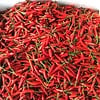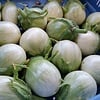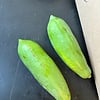acacia leaf/ cha-om leaf
The aroma of Cha-om is not necessarily a pleasant one; one name refers to the plant as “stinky leaf.” Cha-om is a tropical shrub-like plant, with a look similar to that of a fern Read more
Description/Taste
Cha-om is a tropical shrub-like plant, with a look similar to that of a fern. The plant itself can grow up to 5 meters, or 16 feet in height. The long stalks of Cha-om have feathery leaves at the top, where the tender, new shoots emerge. The older stems grow thorns, so care should be taken. In Thailand, vendors selling the vegetable will wrap the stalks in banana leaves and secure with twine to keep customers from pricking their hands with the thorns. The aroma of Cha-om is not necessarily a pleasant one; one name refers to the plant as “stinky leaf.” The overwhelming fragrance is diminished with cooking, but can be rather potent when raw.
Seasons/Availability
Cha-om is available year round in tropical climates, and during the spring and summer months in cooler climates.
Current Facts
Cha-om is an herbaceous vegetable, related to legumes, that grows throughout tropical Southeastern Asia. The plant is a member of the acacia family, and is botanically classified as Acacia pennata. It is sometimes called Climbing Wattle or in Hindi, Agla Bel or Biswal. Cha-om is sometimes known by its botanical synonym, Senegalia pennata.
Nutritional Value
Cha-om is a vitamin-rich vegetable, containing high amounts of vitamin A, calcium and iron, as well as vitamins B and C. The herb is also a good source of fiber and phosphorus. Cha-om contains various beneficial nutrients, such as beta sitosterol, which helps lower cholesterol and promotes prostate health, and tannins, which are anti-microbial and have antioxidant properties.
Applications
Cha-om is a nutritional staple for the people of Thailand. The herb is traditionally added to eggs, in a dish called khai jiao Cha-om (or acacia omelet), it is very similar to a frittata or an egg casserole. The tops are plucked from the stem, seasoned, and added to the eggs prior to cooking. Once cooked, khai jiao Cha-om is cut into squares for serving. The fragrant omelet is served over rice, dipped in a spicy Thai chili sauce, or served in a bowl of Thai sour curry. Store fresh Cha-om in the refrigerator, wrapped in plastic, for up to a week.
Ethnic/Cultural Info
In Southeastern Asia, Cha-om is used medicinally to treat stomachaches, migraines, fevers, digestive troubles and asthma or bronchial infections. It is used as an expectorant for coughs and excessive mucus. All parts of the plant are used, including the roots.
Geography/History
Cha-om is native to tropical Indonesia and the Southeastern Asian countries of Malaysia, Thailand, Laos and Vietnam. It thrives in the humid, tropical environment and grows fast enough to allow trimming and the harvesting of young shoots every few days. Some Cha-om is cultivated; however, much is foraged from its native environment. Cha-om is a perennial in tropical climates, though it will survive in cooler climates and stay dormant over the winter.



 vegetables
vegetables
 fruit
fruit
 chilli
chilli
 eggplant thai
eggplant thai
 NEW project - GREEN PAPAYA THAI.
NEW project - GREEN PAPAYA THAI.
